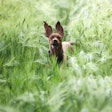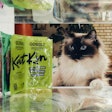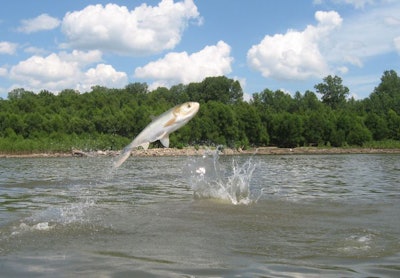
Using invasive species as novel pet food ingredients allows brands to make numerous marketing claims that follow current consumer demand trends. Dog and cat treats made with Asian carp boast of being limited ingredient, made in the USA, wild caught and non-GMO, all while helping freshwater ecosystems and economies. Along with these qualities, dog treats made from feral axis deer in Hawaii, USA also claim to go beyond humane and cruelty-free to become “stressless.” Soon-to-be-released feral hog dog treats can assert that the treats help wildlife conservation and restoration efforts.
While these virtues may help brands stand out in a crowded natural pet food market, using invasive species poses challenges for pet food and treat makers.
"The problem is we need a stable source,” Logan Honeycutt, co-founder of BareItAll Petfoods, told Petfood Industry.
His company introduced dog treats made from non-native Asian carp in 2016. Asian carp species threaten aquatic ecosystems and economies in the US Midwest and South. Since there isn’t much of a market for Asian carp meat in the US, few processors and distributors bother with the low-value fish, which can make it hard to find a steady supplier with enough of the novel pet food ingredient to meet demand.
BareItAll and another brand, Scout and Zoe’s, both found sources for Asian carp, but branching out into other invasive species may be more difficult. Honeycutt said that when his company started planning to make pet treats made from invasive feral hogs, they had trouble locating a source for the meat.
“When there's no industry or supply chain behind the animals, it's very difficult to get safe and secure ingredients," he said.
Ironically, that lack of supply is the opposite of the problem invasive species cause in nature, where the beasts abound. When people release non-native organisms or they escape into the wild, those species may conquer that new ecosystem by devouring resources, reproducing quickly or otherwise out-competing local animals and plants. Large populations of invasive species can force native creatures towards extinction, reduce biodiversity and create costly problems for people.
Asian carp as novel pet food ingredient
For example, Asian carp species eat plankton needed by other fish, procreate prolifically and endanger boaters by leaping from the water. After escaping and being released into American waterways in the 1960s and '70s, Asian carp have reduced the profitability of many freshwater fisheries in the US Midwest and South. Now these unholy mackerel threaten the billion-dollar fishery of the Great Lakes. Expensive barriers and eradication programs have not solved the problem.
Back home in China, chefs prize the fish, yet Asian carp meat is largely unused in the US. Meanwhile, this wasted resource lays waste to aquatic ecosystems. Pet food industry professionals decided that if you can’t beat them … eat them.
“I eat the treats myself,” Cindy Dunston-Quirk, founder of Scout and Zoe’s, told Petfood Industry. “The fish has omega-3 fatty acids, complete protein and it’s low-fat. Another thing, Asian carp doesn’t have lots of mercury or other toxins like some fish … All that has been backed up by research.”
The most common Asian carp species, silver and bighead, eat by filtering tiny plants and animals from the water, as whales do. Since they eat low on the food chain, toxins don’t build up in their meat, or bioaccumulate, as much as in predatory fish. Along with food safety and nutrition, Asian carp can address other health issues.
“For cats with allergies, Asian carp can give them another option,” said Dunston-Quirk.
Economics and Asian carp
Animal health and native ecosystems benefit from the use of Asian carp in pet treats; at the same time it helps struggling American fishermen make a living. Federal regulations prevent fishermen from throwing the invasive carp back into rivers, although nets bring in tons of the fish inadvertently. Those mountains of fish are worth little cash at processors, if the facility will buy them at all.
“When 90 percent of what you catch you can't sell and you can't throw back, the numbers don't work out so well,” said Honeycutt.
BareItAll introduced their Asian carp dog treats in 2016 and added varieties of cat treats this year. Entering the cat treat market opened fresh opportunities for BareItAll, Honeycutt said. Pet treat retailers especially liked that it was an alternative fish protein.
“Retailers that were hesitant on the dog treats, with the cat treats they were like [snaps fingers],” he said. "When they heard that we had a healthy fish protein that's not salmon, they were on board with it instantly. We definitely think we're on to something with the cat side of things."
Feral hogs for the dogs
BareItAll also changed their packaging to match their ecological ethos. The Asian carp pet treats now come in packaging that doesn’t contribute to the vast plastic garbage patches floating in the oceans.
"We use rice paper specifically to get away from plastics as much as possible, because our whole brand is about protecting aquatic ecosystems,” Honeycutt said.
Inside those rice paper packages, pet owners will soon find dog treats made from feral hogs. Although finding a supplier was difficult, Honeycutt expects BareItAll’s feral hog dog treats to be on the market in a few months. In the future, Burmese pythons and lionfish may become BareItAll treats too.
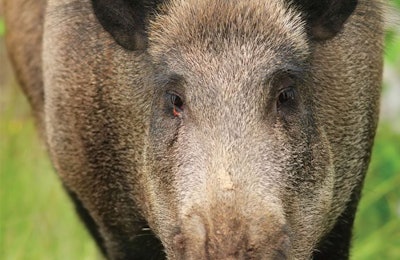
BareItAll will soon offer dog treats made from feral hogs.
As novel pet food ingredients, feral hogs have an advantage over giant snakes and venomous fish, he said. Namely, pork isn’t novel. Federal regulations already approve of pig meat, so there is no need for additional authorizations.
Ever since Spanish conquistadors lost track of some domesticated pigs, feral hogs have roamed the Western Hemisphere, according to the US Department of Agriculture. The runaway pigs reproduced and eventually their descendants were joined by escapees from colonists' farms. Feral hogs now range over most of the US. These pigs damage the ecosystems they invade by trampling and rooting up the soil, which destroys the soil structure, damages roots and allows erosion. Feral hogs also eat native plants and animals, including ground-nesting birds. The wild pigs also devour farmers’ crops and can transmit diseases to livestock, among other problems.
Hawaiian axis deer as novel pet food ingredients
Feral hogs also run wild on Hawaii along with many other invasive species, including the chital or axis deer. The deer were intentionally released on three Hawaiian islands, starting in the 1860s. Without natural predators, the deer population boomed, feasting on endangered native plants and dislodging the soil, which contributes to erosion that smothers coral reefs with silt.
No threats and plenty of food sounds like a sweet life, and Artvark Pet Products took advantage of that to introduce a unique marketing claim that goes beyond cruelty free, humanely raised or other animal welfare claims.
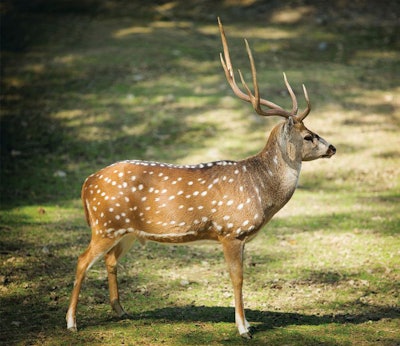
Axis deer run wild on the island of Hawaii.
“What we're trying to do is create a whole new category in the pet industry of ‘stressless’," said Amy Morishita, an Artvark representative. "The deer are living a totally stressless, Hawaiian lifestyle from beginning to end."
The US Department of Agriculture licenses a single hunter to harvest the axis deer, Morishita said. The hunter attempts to use a single shot to kill the deer quickly. So, until that final moment, the deer live without fear, peacefully gorging on the rare, endemic species of Hawaii’s fragile ecosystem.
Worldwide, many other invasive species are living the “stressless,” good life at the expense of native wildlife. Those biological banes could become boons to the pet food industry as the hunt for sustainable, healthy novel pet food ingredients continues.
More on novel pet food ingredients
http://www.petfoodindustry.com/topics/212-pet-food-ingredients










